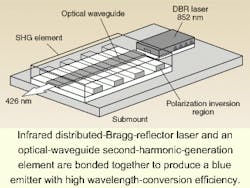SECOND-HARMONIC GENERATION: Tiny blue-laser-light source has low noise
TOKYO - Yokogawa Electric Corp. and Matsushita Electric Industrial Co. Ltd. have jointly developed a compact, low-noise blue-laser-light source combining an infrared semiconductor laser and a second-harmonic-generation (SHG) element. The light source is ideal for development and evaluation of next-generation optical disk devices. It also can be used in optical detection devices where stable light sources are necessary. Yokogawa has commercialized the new light source and begun sales.
The light-emitting component combines an 852-nm distributed-Bragg-reflector (DBR) semiconductor laser developed by Yokogawa and an optical-waveguide SHG element developed by Matsushita (see figure). The semiconductor laser has three electrodes. Its emission wavelength can be precisely controlled by changing the length of the resonance cavity and modulating the optical period of the DBR. Its wavelength-conversion efficiency is 50% better than conventional models. The SHG element is made of a lithium niobate base doped with magnesium oxide and is formed into a periodic polarization-inversion structure. The construction results in lower optical loss in the waveguide and a deeper formation of the polarization inversion layer.
Initially, these elements were optically linked by placing lenses between them. However, by bonding them directly, a component is created that is more compact and mechanically stable. The volume of the component is approximately 1 cm3.
The resulting laser light source is single-mode and has a 425-429-nm output. The device has an optical power of 1.5 mW and a linewidth of less than 2 MHz; its relative noise is -140 dB/Hz—a mere tenth of the noise produced by blue gallium nitride-based semiconductor lasers or other SHG blue lasers. Wavelength fluctuations during operation can be controlled to less than 0.1 nm.
The two collaborating companies claim that this light source can be used for high-precision evaluation of disk media and lenses for blue-laser optical-disk devices and that development of optical-disk devices will accelerate as a result. It is also predicted that the lasers will be used beyond the development stage as an optical-head light source for optical disks. Because the wavelength of the emitter is short and its linewidth is very narrow, it can also be used as a light source for optical measurement devices such as interferometers.
Courtesy O plus E magazine
